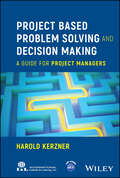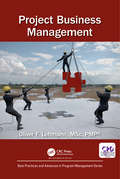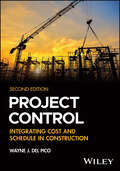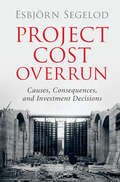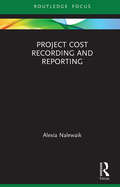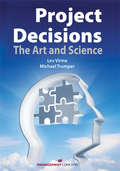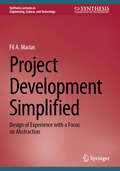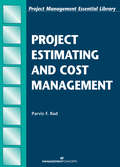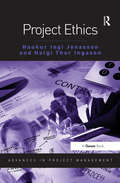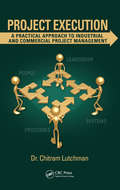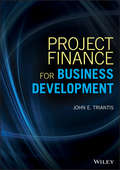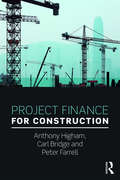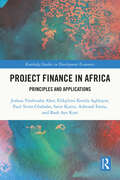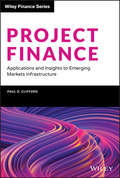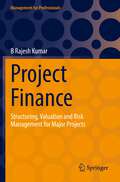- Table View
- List View
Project Based Problem Solving and Decision Making: A Guide for Project Managers
by Harold KerznerPROJECT BASED PROBLEM SOLVING AND DECISION MAKING A project manager’s guide to solving complex project issues and making strategic decisions An everyday resource for project managers who are tasked with identifying and solving complex problems, Project Based Problem Solving and Decision Making offers valuable guidance on how to make informed decisions that move projects forward, provides project managers with expert advice for communicating clearly and effectively with team members and project stakeholders, and describes how to effectively lead project teams and empower team members to make strategic project decisions. Written by Dr. Harold Kerzner, bestselling author and one of the leading minds in project management, Project Based Problem Solving and Decision Making includes information on: Developing effective problem-solving and decision-making???important skills for professional project managers Leading teams, setting and achieving goals, and making sure that projects are completed on time and within budget Identifying and solving problems that arise during complex projects, and making informed decisions that move projects forward Using a project-based approach: breaking the project down into smaller, manageable??chunks and tackling each one separately Focusing on specific problems or decisions and implementing solutions tailored to the??specific needs of the project Project Based Problem Solving and Decision Making is an essential everyday resource for professional project managers, as well as students studying project management. Dr. Kerzner is not only a world-renowned author in project management but also serves as the Senior Executive Director at the International Institute for Learning, Inc. (IIL). To explore more about IIL’s offerings, visit www.iil.com or get in touch via email at learning@iil.com.
Project Business Management (Best Practices in Portfolio, Program, and Project Management)
by Oliver F. LehmannRoughly half of all project managers have to lead customer projects as profit centers on contractor side with two big objectives: making the customer happy and bringing money home. Customer projects are a high-risk business on both sides, customers and contractors, but the dynamics of this business have so far been mostly ignored in literature. The book is intended to fill this gap. The book helps project managers better understand the dynamics of customer projects under contract from business development through handover and find solutions for common problems. A central aspect is international contract laws, an often underestimated factor in projects.
Project Control: Integrating Cost and Schedule in Construction (Rsmeans Ser.)
by Wayne J. Del PicoPROJECT CONTROL Reader-friendly, integrated approach to construction project cost and scheduling control, with all-new pedagogical elements The Second Edition of Project Control is an introductory practical guide that explores the reasons and methodologies for proper planning, monitoring, and controlling project costs and schedule and shows how productivity models are created, monitored, and controlled, as well as how corrective actions are implemented as deviations from the baseline occur. Project Control uses simple language to convey project control principles, making it an excellent resource to teach with and learn from in a classroom setting. This Second Edition has been updated with all-new pedagogical elements and ancillary materials for use in the construction project management classroom. This new edition features all-new sections on baseline scheduling, estimate development, probability analysis, and more. Written by Wayne Del Pico, a seasoned professional with over 40 years of experience in construction project controls, Project Control includes detailed information on: Role of the project manager, covering leading the project team, creating the project plan, developing the project schedule, and monitoring project progress over time Project control cycles, covering plans to achieve goals, executing work according to plan, identifying variations and their causes, and executive work and measure changes Pre-construction planning, covering key personnel and responsibilities and establishing baselines for schedule and cost control Budgeting, covering types of estimates, organization estimates, and harnessing the budget as a management tool Providing expert insight into the management skills of the project manager combined with the analytical focus of the accountant and the “big picture” oversight of the executive, Project Control is an essential resource for students in construction management programs and professionals in construction firms with specializations in long-term infrastructure projects.
Project Cost Overrun: Causes, Consequences, and Investment Decisions
by Esbjörn SegelodCost overrun is common in public and private sector projects. Costs tend to grow, plans fail and financial problems follow, but how can we approve the right projects if we cannot estimate their true cost? This book, for academics in project management, management accounting and corporate finance, as well as for managers in the public and private sectors, offers a new way of thinking about the causes and consequences of cost overrun for firms and society. It demonstrates that there is a logic behind cost growth and overrun, identifies projects and situations that are more vulnerable, and examines the effects of increased costs. It further identifies the negative and positive consequences of cost overrun, analyses how and why preconditions for cost overrun differ when the logic governing private firms dominates versus the logic of the political sector, and explains why cost can sometimes be of lesser importance to decision makers. Approaches the topical subject of project cost overrun in a new light, providing new perspectives and approaches on the positive effects of cost overrun, differences in the logic of economics and politics, and terror management theory. Provides scholarly, critical analysis and evidence to support the practical backbone of the work, allowing readers to apply their knowledge to real-life situations. Approaches private and public sector projects with equal importance, using previously-unseen data from the private sector to highlight valuable lessons on cost overrun.
Project Cost Recording and Reporting
by Alexia NalewaikCommunication is a vital part of project management, and reports are one of the preferred vehicles for transmitting information to an intended internal or external audience. Reports are also part of the system of control and governance on projects, used to bring attention to issues and prompt action to improve project outcomes. There are countless ways of combining project information for consumption by stakeholders. This book discusses the purpose of project reports, and provides examples of the format, content, timing, and audience for various types. Using principles of stakeholders and risk management, it presents a rationale for communication plans, enabling appropriate reporting at the project, program, and portfolio level. The author also: Presents tangible experience and suggestions for developing project reports. Discusses project reports in context, as applicable to types of stakeholders and the project lifecycle. Identifies sources and types of data required for adequate reporting. Offers examples of report formats, graphics, and content. Reflects on typical challenges encountered with project reporting. It is essential reading for practitioners and students of project management, cost control, and accountancy.
Project Debt Free: A Practical Guide To Financial Freedom
by Frederick O. Towles<i>Project Debt Free</i> explains the culture of debt in America, highlights the reason for your money troubles, and provides a realistic plan for successfully becoming debt free. While this plan will not get you out of debt overnight, it outlines steps to put you on the road to debt freedom - and keep you on that road.
Project Decisions, 2nd Edition: The Art and Science
by Lev Virine Michael TrumperThis new edition gives project managers practical methods and tools to make the right decisions while juggling multiple objectives, risks and uncertainties, and stakeholders. Project management requires you to navigate a maze of multiple and complex decisions that are an everyday part of the job. To be effective, you must know how to make rational choices with your projects, what processes can help to improve these choices, and what tools are available to help you with decision-making. An entertaining and easy-to-read guide to a structured project decision-making process, Project Decisions will help you identify risks and perform basic quantitative and qualitative risk and decision analyses. Lev Virine and Michael Trumper use their understanding of basic human psychology to show you how to use event chain methodology, establish creative business environments, and estimate project time and costs. Each phase of the process is described in detail, including a review of both its psychological aspects and quantitative methods.
Project Decisions: The Art and Science
by Lev Virine Michael TrumperProject management is the art of making the right decisions. To be effective as a project manager, you must know how to make rational choices in project management, what processes can help you to improve these choices, and what tools are available to help you through the decision-making process. Project Decisions: The Art and Science is an entertaining and easy-to-read guide to a structured project decision analysis process. This valuable text presents the basics of cognitive psychology and quantitative analysis methods to help project managers make better decisions. Examples that portray different projects, real-life stories, and popular culture will help readers acquire the essential knowledge and skills required for effective project decision-making. Readers will be able to: •Understand psychological pitfalls related to project management•Establish a creative business environment in their organization•Identify project risks and uncertainties•Develop estimates of project time and cost based on an understanding of human psychology•Perform basic quantitative and qualitative risk and decision analysis•Use event chain methodology in managing projects•Communicate the results of decision analysis to decision-makers•Review project decisions and perform adaptive project management•Establish a project decision analysis process in their organization PLUS — Test your own judgment through a quiz that examines your intuition!
Project Delivery in Business-as-Usual Organizations
by Tim CarrollBusiness organizations are highly successful at delivering 'business as usual'; the day-to-day tasks of managing customer transactions, marketing and production activities, and motivating employees. But there is a growing requirement for such organizations also to deliver business change projects successfully. 'Business as usual organizations' represent a particularly challenging environment for achieving this because of the fundamentally different mindset and culture required to deliver projects in this context. Tim Carroll's book provides an authoritative guide to improving project delivery in such organizations by: ¢ building a project management capability and culture that is appropriate to BAU organizations; ¢ aligning projects more closely with the strategic agenda of the organization, through the use of programmes; ¢ using portfolio management to improve this alignment and ensure the effectiveness of project investments; ¢ demonstrating the business context for projects and their contribution to the organization's agenda of strategic change. The author argues convincingly that project management hasn't travelled well from its traditional roots in construction and engineering to business-as-usual organizations. New approaches are called for, in particular to embed project delivery capabilities more deeply within the organization rather than treat it as a specialist discipline. This is a 'must-read' book to help managers responsible for strategy and change in all business-as-usual organizations (such as banks, insurance, business and consumer service companies, hospitals, local and national government) to realize the value that project management can bring to the long-term development of their organization.
Project Deutschland: Unpeeling the Onion of a Distressed Real Estate Portfolio
by Nori Gerardo Lietz Ricardo AndradeJames Tallest analyzed the opportunity to invest in a distressed portfolio of high quality properties in Germany by acquiring one or more non-performing loans from Deutschland Bank. While he considers the many aspects of the deal that is about to unfold, he must decide which securities to acquire, the price he should offer to each of them, and whether to retain the former owner of the portfolio as property manager.
Project Deutschland: Unpeeling the Onion of a Distressed Real Estate Portfolio
by Nori Gerardo Lietz Ricardo AndradeJames Tallest analyzed the opportunity to invest in a distressed portfolio of high quality properties in Germany by acquiring one or more non-performing loans from Deutschland Bank. While he considers the many aspects of the deal that is about to unfold, he must decide which securities to acquire, the price he should offer to each of them, and whether to retain the former owner of the portfolio as property manager.
Project Development Simplified: Design of Experience with a Focus on Abstraction (Synthesis Lectures on Engineering, Science, and Technology)
by Fil A. MaciasThis book explains and outlines the use of hierarchical abstraction for project development. The author details the need for effective strategies for project development and provides a thorough explanation of hierarchical abstraction. The book instructs readers on how they may apply this method of organizing information or concepts into a layered structure in order to make ideas more manageable. The author then explains how this process also simplifies the representation and analysis of information, allowing readers to extract meaning and identify relationships within a system. The book shows how hierarchical abstraction can also be implemented for more effective disbursement of information. The author includes extensive discussion of the applications for a variety of fields, including computer science, information architecture, and cognitive psychology.
Project Development in the Solar Industry
by Albie Fong Jesse TippettThis book written by practicing experts in the solar renewable energy field enables readers to understand both renewable project development and the primary stumbling blocks in the process. It also contains a detailed description of all renewable energy technologies, the development activities required, and an overview to software & mapping tools commonly used in the industry. The book will not only serve as a guide to project developers but it will also assist policy makers and stakeholders in understanding the process involved to turn the sun into electricity and the reasons for supporting solar.
Project Dreamcast: Serious Play at Sega Enterprises Ltd. (A)
by Andrew Robertson Stefan ThomkeFocuses on the ongoing competitive battles in the global home video game market that is estimated to exceed $15 billion by 1999 in the United States and Japan alone. Describes how Sega Enterprises has redesigned its development processes to create a revolutionary 128-bit video game console (named Dreamcast). Having lost its leading position in an accelerating market to Sony's Playstation console, Sega is trying to reclaim its former position through an aggressive entry strategy in the Japanese market. Integral to this strategy is the ability to bring its Dreamcast console to market rapidly and to manage its relationships with independent game developers. Focuses on: 1) hardware and game software development, 2) the role of market share in an environment of increasing economic returns, and 3) the dynamics of market entry strategies as a function of development capabilities and competitive responses.
Project Estimating and Cost Management
by Parivs F. Rad PhD, PMPImprove the accuracy of project estimates and make better in-progress modifications by following the discipline-independent approach mapped out in this book. Learn the best ways to apply new tools, including a breakdown structure for both work and resources and proven estimating models. In addition, you'll gain insights into best practices for progress monitoring and cost management, as well as for dealing effectively with external projects.
Project Ethics (Advances in Project Management)
by Helgi Thor Ingason Haukur Ingi JonassonHow relevant is ethics to project management? The book - which aims to demystify the field of ethics for project managers and managers in general - takes both a critical and a practical look at project management in terms of success criteria, and ethical opportunities and risks. The goal is to help the reader to use ethical theory to further identify opportunities and risks within their projects and thereby to advance more directly along the path of mature and sustainable managerial practice. Project Ethics opens with an investigation of the critical success factors in project management. It then illustrates how situations can arise within projects where values can compete, and looks at how ethical theories on virtue, utility, duty and rights can be used as competence eye-openers to evaluate projects. The reader is challenged to think of their project management experiences where questions of competing values surfaced, and mirror them in short vignettes taken from real practice from all round the globe. Finally, a new method is introduced, based on classical ethical theory, which can help project owners, project managers, project teams and stakeholders, to identify, estimate and evaluate ethical opportunities and risks in projects.
Project Execution of Mega-Projects for the Oil and Gas Industries
by Soosaiya AnthreasThis book covers execution of mega industrial projects especially in oil and gas industries covering engineering, procurement, construction, commissioning and performance testing. It enumerates various tasks and deliverables under each discipline and sub-disciplines to define the detailed scope of work, supplies and services, as per level III of Prima Vera Schedule developed from the contract-based schedule. It gives an overall idea of how a project rolls out from commencement date to initial acceptance and executed practically with total contractor’s scope of work broken down into tasks/activities at level III platform, while highlighting that support for fool proof project execution.
Project Execution: A Practical Approach to Industrial and Commercial Project Management
by Chitram LutchmanWritten by Chitram Lutchman, a project management professional with more than 20 years of field and business experience, Project Execution: A Practical Approach to Industrial and Commercial Project Management gives you a more optimistic view of this exciting and challenging area. The book focuses on the essential requirements for successful executi
Project Feasibility: Tools for Uncovering Points of Vulnerability (Systems Innovation Book Series)
by Olivier MeslyThis book presents a set of tools that will aid in deciding whether a project should go ahead, be improved, or abandoned altogether by pinpointing its vulnerabilities. It offers a review of project feasibility analysis, and more critically, psychodynamic aspects that are often neglected, including how stakeholders interact. It provides a complement to the common techniques used for analyzing technical, financial, and marketing feasibility. The goal is to identify "hidden truths" and eliminate those gray areas that jeopardize the success of a given project. The focus is on uncovering points of vulnerabilities in four key aspects of a project: People, Power, Processes, and Plan.
Project Finance Glossary
by Benjamin C. EstyDescription: This glossary contains a list of almost 1,000 definitions for terms commonly used in the field of project finance.
Project Finance for Business Development (Wiley and SAS Business Series)
by John E. TriantisRaise the skill and competency level of project finance organizations Project Finance for Business Development helps readers understand how to develop a competitive advantage through project finance. Most importantly, it shows how different elements of project finance, such as opportunity screening and evaluation, project development, risk management, and due diligence come together to structure viable and financeable projects—which are crucial pieces missing from the current literature. Eliminating misconceptions about what is really important for successful project financings, this book shows you how to develop, structure, and implement projects successfully by creating competitive advantage. By shedding light on project finance failures, it also helps you avoid failures of your own. • Offers a roadmap for successful financing, participant roles and responsibilities, and assessing and testing project viability • Considers project finance from a broad business development and competitive advantage • Provides a strategic decision-forecasting perspective • Delves deeper than existing treatments of project finance into decisions needed to create and implement effective financing plans Helping readers develop, structure, and implement projects successfully by creating competitive advantage, this book is a useful tool for project sponsors and developers, helping them structure and implement projects by creating competitive advantage.
Project Finance for Construction
by Peter Farrell Anthony Higham Carl BridgeThe world of construction is intrinsically linked with that of finance, from the procurement and tendering stage of projects right through to valuation of buildings. In addition to this, things like administrations, liquidations, mergers, take-overs, buy-outs and floatations affect construction firms as they do all other companies. This book is a rare explanation of common construction management activities from a financial point of view. While the practical side of the industry is illustrated here with case studies, the authors also take the time to build up an understanding of balance sheets and P&L accounts before explaining how common tasks like estimating or valuation work from this perspective. Readers of this book will not only learn how to carry out the tasks of a construction cost manager, quantity surveyor or estimator, they will also understand the financial logic behind them, and the motivations that drive senior management. This is an essential book for students of quantity surveying or construction management, and all ambitious practitioners.
Project Finance in Africa: Principles and Applications (Routledge Studies in Development Economics)
by Joshua Yindenaba Abor Elikplimi Kolma Agbloyor Paul Gbahabo Saint Kuttu Ashenafi Fanta Baah Aye KusiInfrastructure drives economic growth and sustainable development by facilitating productivity, attracting foreign investment, promoting industrialisation, reducing poverty, improving standards of living, and enhancing human development. Thus, the development of project-oriented frameworks/institutions that offer long-term infrastructure financing has been identified as a core and guaranteed way to maximise economic growth and development, especially for developing regions like Africa. Project finance has a critical role in infrastructure development. This book examines the project finance ecosystem, methods, analysis, and key-related risks. Its unique contribution to the literature is its focus on Africa, where there is a huge infrastructure investment deficit and a lack of technical know-how to bridge this gap. Following a detailed introduction to project finance, the book investigates project viability, project characteristics, risk analysis and management, structure and legal issues in the context of project finance, as well as project finance markets, banks and syndicated lending, financing the deal, and the role of project advisors. It also offers insight into financial modelling and project evaluation, credit risk in project finance from the lender’s perspective, and the role of project finance in the petroleum industry. The book provides two African-related case studies of project finance. The book incorporates theoretical perspectives, valuable policy insights and resources, and offers strategies to improve and reform the structure and implementation of project finance in Africa. It provides scholarly and professionally engineered knowledge, and while each chapter explains and discusses several related issues, the case studies offer a real-life learning and teaching experience for academics and students to enhance their understanding of the issues under discussion.
Project Finance: Applications and Insights to Emerging Markets Infrastructure (Wiley Finance)
by Paul D. CliffordTackle infrastructure development projects in emerging markets with confidence In Project Finance: Applications and Insights to Emerging Markets Infrastructure, distinguished professor and author Paul Clifford insightfully applies the fundamental principles of project finance structuring to infrastructure investments in emerging markets. Using leading emerging market case studies to illuminate the underlying themes of the book, the author provides a practitioner’s perspective and incisive analysis of concepts crucial to a complete understanding of project finance in emerging markets, including: · Risk management · ESG and impact investing · The emergence of new global multilateral development banks · China’s Belt and Road Initiative Project Finance bridges the gap between theoretical infrastructure development, investment, and finance and the implementation of that theory with instructive and applicable case studies. Throughout, the author relies on a grounded and quantitative approach, combining the principles of corporate finance with straightforward explanations of underlying technologies, frameworks, and national policies. This book is an invaluable resource for undergraduate and graduate students in finance, as well as professionals who are expected to deal with project and infrastructure finance in emerging markets.
Project Finance: Structuring, Valuation and Risk Management for Major Projects (Management for Professionals)
by B Rajesh KumarLarge projects are defining moments for companies and countries. When large projects succeed, they can dramatically improve the social and economic conditions in a region. This book focuses on major aspects of the world’s largest infrastructural, industrial and public service projects through the lens of structuring, valuing, managing risk and financing projects. The book analyses and discuss large projects in government, private and public and private partnership. The author sheds light into the attributes of project finance which have unique structural elements. The book focuses on case studies related to 50 mega projects which includes infrastructural projects, energy related projects, industrial projects, roads, ports and bridges among others. This book covers both the theoretical aspects of financing of mega projects and the practical applications by including case studies of the world’s largest projects in terms of value.
